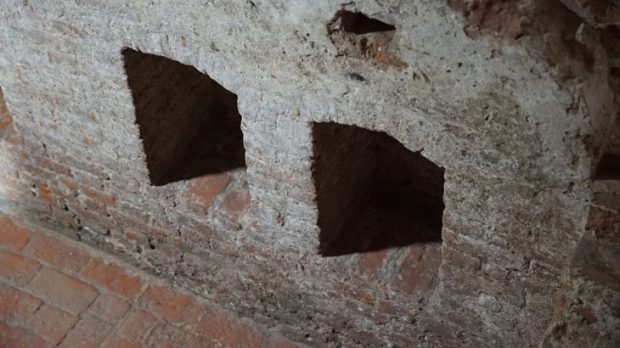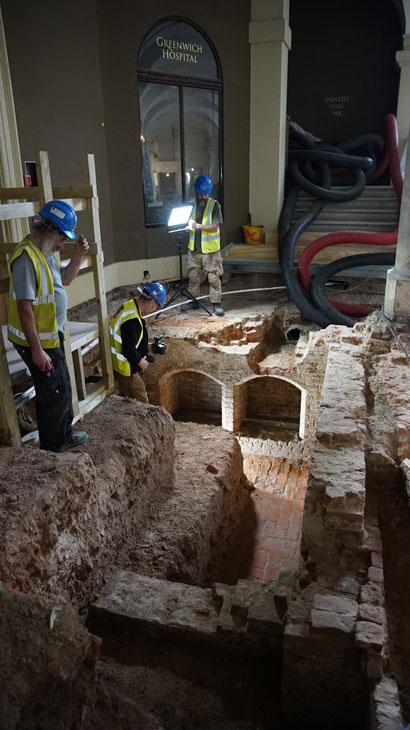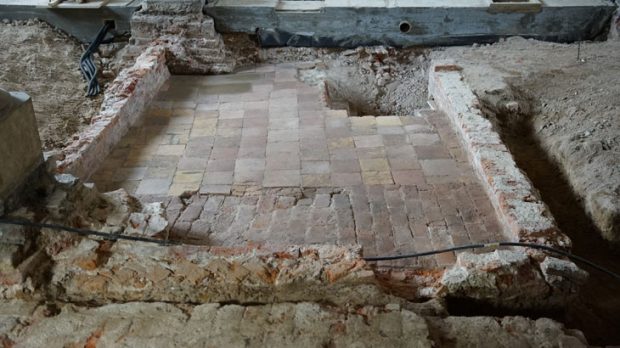In Greenwich work currently underway to turn the undercroft of the Old Royal Naval College’s Painted Hall into a visitor centre for Sir James Thornhill’s newly conserved masterpiece has uncovered a rare surprise; the well preserved remains of the cellars of the Tudor royal palace. The royal house at Greenwich was established along with the neighbouring friary by Henry VII, who, during the course of his reign, built there a brick courtyard house with an impressive river frontage. It was his son, Henry VIII, however who really established Greenwich as the premier royal house. Following the devastating fire at the Palace of Westminster in 1512 and before the acquisition of Whitehall from Cardinal Wolsey in 1529, Greenwich was his main residence near London. Here Henry established vast tiltyards where he could indulge his passion for the tournament and based the workshops of his renowned German armourers. Before it succumbed to the dissolution the friary church, and the Franciscan brothers it was home to, played a central part in the religious life of the royal household.

Remains of the old Tudor Palace at Greenwich © Old Royal Naval College, Greenwich
Little now survives of this once great royal manor. The old Tudor brick buildings were demolished to make way for Charles II’s ambitious but ultimately abortive palace, and finally subsumed by the wings of Sir Christopher Wren’s naval hospital. Although much has been written about the architectural development of the site, thanks to previous archaeology and to the rich archival record by the likes of Sir Howard Colvin and Sir John Summerson in The History of the King’s Works (1982) and latterly by Simon Thurley, there is much still that can be learnt from new discoveries such as that below the Painted Hall. In fact any archaeological find at Greenwich is to be celebrated since they occur so rarely. The last big discovery was made in 2006 when part of the tiled floor of the chapel was uncovered. In 2003, Time Team’s survey revealed glimpses of the tiltyard towers. And major excavations in 1970–71 helped to establish the position and plan of parts of the royal lodging.

Remains of the old Tudor Palace at Greenwich © Old Royal Naval College, Greenwich
The new archaeological discovery below the Painted Hall is particularly exciting because it was so unexpected. Although it is difficult to be precise about its position in relation to the main buildings of the palace and the friary it is seemingly located in an area of land between the two and the vast tiltyard to the south. This is an area that is left blank on the reconstructed plans printed in the works cited above and so adds a previously unknown piece to the jigsaw puzzle. The significance of the find is increased still because it is clearly the remains of a substantial brick building with multiple rooms and more than one storey. The archaeologists who have surveyed it identify the brickwork as dating from the period 1520–30 and the glazed Flemish tile floor in one of the two visible rooms as broadly of the same period.
The glazed tile floor is in the upper of the two revealed spaces, while the lower space adjoining to but not communicating with it has a more utilitarian brick floor set a metre or two below the level of the finer pavement above. This space was evidently a brick-vaulted cellar with a low ceiling height. Niches are set into two of the surviving walls, some of which have caused a flurry of excitement among the archaeologists who have speculated that they might be bee boles for overwintering bee skeps. This is an extraordinary conclusion and perhaps needs a little more time to be tested. Bee boles are found all around the country in garden walls and in purpose-built structures, but indoor examples are very rare (the IBRA’s Bee Bole Register records just 63 examples of which only a handful date from the 16th century). However, if these are indeed bee boles, as certainly seems possible, then they represent a unique survival in the context of an English royal house and tantalising evidence of the production of honey and wax for consumption by the household and the friary.

Remains of the old Tudor Palace at Greenwich © Old Royal Naval College, Greenwich
Inevitably the discovery of major archaeology during building works changes well-laid plans but I’m told that the Greenwich Foundation for the Old Royal Naval College, the charity that cares for the site, is already considering ways to keep the archaeology on show within their new visitor centre. It is reliant on quickly raising the additional funds of course, but if they are able to do so it will be a fantastic addition to what already promises to be a greatly improved space. Nowhere else at Greenwich is the Tudor palace visible (there is a small surviving cellar below a nearby building but it is rarely accessible to the public). Being able to offer visitors even a tiny glimpse of the remains of this once great royal house will be an astonishing outcome from this wonderful project.

The traces of the Tudor palace at Greenwich are a truly remarkable find
Old Greenwich Place (early 17th century), artist unknown. © National Trust Images
Share
In Greenwich work currently underway to turn the undercroft of the Old Royal Naval College’s Painted Hall into a visitor centre for Sir James Thornhill’s newly conserved masterpiece has uncovered a rare surprise; the well preserved remains of the cellars of the Tudor royal palace. The royal house at Greenwich was established along with the neighbouring friary by Henry VII, who, during the course of his reign, built there a brick courtyard house with an impressive river frontage. It was his son, Henry VIII, however who really established Greenwich as the premier royal house. Following the devastating fire at the Palace of Westminster in 1512 and before the acquisition of Whitehall from Cardinal Wolsey in 1529, Greenwich was his main residence near London. Here Henry established vast tiltyards where he could indulge his passion for the tournament and based the workshops of his renowned German armourers. Before it succumbed to the dissolution the friary church, and the Franciscan brothers it was home to, played a central part in the religious life of the royal household.
Remains of the old Tudor Palace at Greenwich © Old Royal Naval College, Greenwich
Little now survives of this once great royal manor. The old Tudor brick buildings were demolished to make way for Charles II’s ambitious but ultimately abortive palace, and finally subsumed by the wings of Sir Christopher Wren’s naval hospital. Although much has been written about the architectural development of the site, thanks to previous archaeology and to the rich archival record by the likes of Sir Howard Colvin and Sir John Summerson in The History of the King’s Works (1982) and latterly by Simon Thurley, there is much still that can be learnt from new discoveries such as that below the Painted Hall. In fact any archaeological find at Greenwich is to be celebrated since they occur so rarely. The last big discovery was made in 2006 when part of the tiled floor of the chapel was uncovered. In 2003, Time Team’s survey revealed glimpses of the tiltyard towers. And major excavations in 1970–71 helped to establish the position and plan of parts of the royal lodging.
Remains of the old Tudor Palace at Greenwich © Old Royal Naval College, Greenwich
The new archaeological discovery below the Painted Hall is particularly exciting because it was so unexpected. Although it is difficult to be precise about its position in relation to the main buildings of the palace and the friary it is seemingly located in an area of land between the two and the vast tiltyard to the south. This is an area that is left blank on the reconstructed plans printed in the works cited above and so adds a previously unknown piece to the jigsaw puzzle. The significance of the find is increased still because it is clearly the remains of a substantial brick building with multiple rooms and more than one storey. The archaeologists who have surveyed it identify the brickwork as dating from the period 1520–30 and the glazed Flemish tile floor in one of the two visible rooms as broadly of the same period.
The glazed tile floor is in the upper of the two revealed spaces, while the lower space adjoining to but not communicating with it has a more utilitarian brick floor set a metre or two below the level of the finer pavement above. This space was evidently a brick-vaulted cellar with a low ceiling height. Niches are set into two of the surviving walls, some of which have caused a flurry of excitement among the archaeologists who have speculated that they might be bee boles for overwintering bee skeps. This is an extraordinary conclusion and perhaps needs a little more time to be tested. Bee boles are found all around the country in garden walls and in purpose-built structures, but indoor examples are very rare (the IBRA’s Bee Bole Register records just 63 examples of which only a handful date from the 16th century). However, if these are indeed bee boles, as certainly seems possible, then they represent a unique survival in the context of an English royal house and tantalising evidence of the production of honey and wax for consumption by the household and the friary.
Remains of the old Tudor Palace at Greenwich © Old Royal Naval College, Greenwich
Inevitably the discovery of major archaeology during building works changes well-laid plans but I’m told that the Greenwich Foundation for the Old Royal Naval College, the charity that cares for the site, is already considering ways to keep the archaeology on show within their new visitor centre. It is reliant on quickly raising the additional funds of course, but if they are able to do so it will be a fantastic addition to what already promises to be a greatly improved space. Nowhere else at Greenwich is the Tudor palace visible (there is a small surviving cellar below a nearby building but it is rarely accessible to the public). Being able to offer visitors even a tiny glimpse of the remains of this once great royal house will be an astonishing outcome from this wonderful project.
Unlimited access from just $16 every 3 months
Subscribe to get unlimited and exclusive access to the top art stories, interviews and exhibition reviews.
Share
Recommended for you
The first classical building in Britain gets the modern treatment it deserves
The Queen’s House in Greenwich is steeped in so much history that curators have struggled to decide what to highlight. But now the problem seems to have been solved
Art Fund invites crowdfunding for clean-up job at Greenwich’s Painted Hall
Art News Daily : 11 August
Culture Clash at the Royal Museums Greenwich
The RMG’s self-reflective conference looked at how contemporary art can contribute to historic contexts